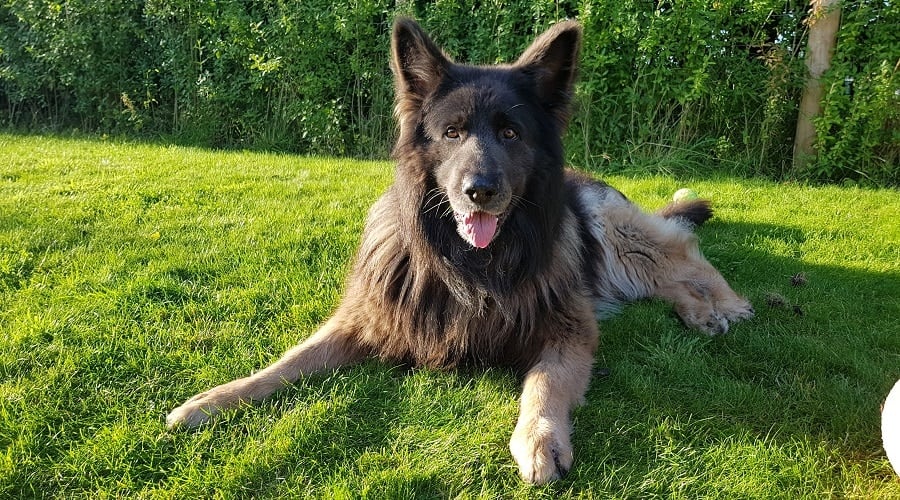In this article, we are going to look at the Blue German Shepherd in detail and how he differs from the traditional German Shepherd’s black & tan color. Technically, he is not blue. The breed is more of a dark gray color. While these alternate colors are becoming increasingly popular, they are still rare to find.
There is controversy around the coloring of this pup, just like the White GSD. It’s not usually considered an accepted color like the Black German Shepherd or the more highly recognized black and tan dogs.
He is fun, he is smart, he is beautiful, and he makes an awesome family pet. Other than his color and the controversy surrounding him, there is not a noteworthy difference between him. So, without further ado, let’s introduce this guy and see what all the fuss is about.
German Shepherd History

The German Shepherd’s journey began in the early 19th Century in northern Germany. During that time, herding dogs varied from area to area. A German Cavalry Officer, Von Stephanitz, dreamt of creating a standard dog that was exemplary in his area of expertise. Across four decades, breeding the best canines from each district, Von Stephanitz engineered the German Shepherd that we know and love today.
The German Shepherd is currently ranked by the American Kennel Club (AKC) as the 4th most popular dog in America. His popularity is not solely based on the amount of German Shepherd working dogs in America, but also the many that make for a great family pet.
It is unknown when the first Blue German Shepherd appeared. However, according to the AKC, along with the liver color, the color is said to be a serious fault. There is a lot of controversy within the German Shepherd world about the blue coat. Many believe that despite being blue in color, they are still purebred and should not be considered a fault. Some breed purists say that the blue color is simply a gene mutation. As such, the Blue German Shepherds should never be bred from. Some advocate the color being bred out completely.
Blue Color Genetics

The color of the Blue German Shepherd is, in essence, a diluted version of the traditional Black Shepherd. Geneticists often use the term ‘diluted’ when referring to the variations in color to reflect the ‘watered down’ color version. The ‘Dd’ dilution gene affects coat color in the main but can also change the color of eyes and noses.
All coat colors and patterns are controlled by a set or group of genes that work together. In standard German Shepherds, you will see descriptions and breakdowns that speak of the A genes, which control the black and red coloring in the dog through the release of melanin, and this affects the generic base color and variations.
Gene Types
However, the coloring of the Blue German Shepherd is controlled by a different gene, the D gene spoken of earlier. It is a gene that is present in all standard German Shepherds. The gene is responsible for both full color when active and for diluted when inactive, just like an ‘on and off’ switch. All genes come in pairs, and it takes the presence of the big ‘D’ and little ‘d’ pair to produce the Blue German Shepherd. The big D produces a full-strength coat color and is the dominant gene. The little d produces a dilute color, which is the recessive gene.
The Blue German Shepherd, technically being a dilute Black Shepherd, comes from the following gene pairings:
- Traditional Black German Shepherd: DD
- Traditional Black German Shepherd: Dd
- Blue German Shepherd: dd
So, for the Blue Shepherd to be created, he needs two copies of the dilute gene. One comes from each parent in order to have dilute fur. Sometimes, he will be bred, especially for his color, from two parents of the same color. On a rare occasion, he will be born into a family of non-blue parents. This only happens if they are both carriers of the recessive gene.
Blue Color Variations
In addition to the above, the Blue German Shepherd takes three variations in blue color. They come in blue and black, blue and sable, and blue and tan, and again, it all is dependent on other different genes.
Additionally, the Blue German Shepherd can also be a variety of lighter and darker blues. Steel blue is the darker shade, and powder blue is the lighter of the two. It can be difficult to identify a steel blue. When you stand him next to a Black German Shepherd, you can easily tell the difference in color.
According to the AKC, the blue color is a serious fault in their genes. While they can still be entered into activity events, they are rarely entered because darker German Shepherds are favored. Many owners who have an unfavorable colored German Shepherd suggest that their pups face color discrimination in events despite being allowed to enter. There are other similar breeds that will share the blue fault, like the GSD cousin – the Belgian Malinois.
Long-coated GSD’s are also considered faulty. Some of the “faulty” dogs are often confused with GSD mixes.
Appearance

Other than the color of his coat, the Blue German Shepherd will follow the same characteristics as any standard German Shepherd.
The males will weigh between 65 and 90 pounds. They will measure 24 to 26 inches in height from paw to shoulder, also known as the withers. The females will weigh between 50 and 70 pounds and will measure 22 to 24 inches at the withers. In addition to the blue, the German Shepherd’s coat can also be gray, sable, white, black, black, and red, as well as other variations of these coats.
As mentioned before, the color ‘blue’ is not blue at all. It has the appearance of a dark gray. Imagine having a Black German Shepherd and accidentally dropping a bag of flour over him. That’s what this beautiful color looks like. Despite his beauty, the AKC considers the color to be a serious fault.
Additionally, it is common for the Blue German Shepherd to have lighter-colored eyes. They are usually light blue, golden brown, or yellow compared to the darker eyes of the other colored German Shepherds. Again, this is controlled by the dilute gene.
Because of his appearance, the Blue German Shepherd is often mistaken for a blue Malinois. With his yellow eyes, he can even look similar to a dark gray wolf. It is believed that the wolf was an ancestor of the German Shepherd.
Temperament

The German Shepherd is a favored family pet across the globe, and this is no different for the Blue German Shepherd. They are known to be super affectionate with their immediate family and enjoy a cuddle on the sofa. This is particularly true of his master, or the one whom he sees as his main caregiver, as the German Shepherd is known to be a “one-man dog.”
The Blue German Shepherd is known for his confident and courageous personality. His guarding tendencies, as long as he is trained and socialized properly, can be utilized in the family environment. However, he can be aloof with strangers or outsiders of the pack, even if they are welcomed onto the estate. But once they have approved newcomers, he is just as loyal and sweet with them as they are with their own pack.
Exercise & Training

The Blue German Shepherd, like any other German Shepherd, is a medium-energy dog and requires up to 60 minutes of exercise a day, which needs to be high-intensity exercises such as interactive games or agility courses. They are extremely intelligent and excel in protection and military professions.
He also will require mental stimulation throughout the day, such as playing interactive games with his master, patrolling the yard, or taking part in training sessions. Because of his guarding tendencies, early socialization is key to a happy hound and household. It is critical for him to be exposed to a variety of situations and a range of sounds, as well as other dogs of all shapes and sizes.
You’ll want to make sure that you train properly, especially if you plan to train your GSD with a harness. They are working dogs, and they like to pull if they are not trained properly. Same thing with crate training – make sure you have the perfect sized crate.
Health & Nutrition

The Blue GSD has the same health tendencies as the normal black and tan variants. His lifespan is 7 to 10 years.
Unlike other breeds, such as the French Bulldog, the color blue is not indicative of health issues or problematic personality traits. The diluted gene can also produce health issues in other breeds. It can produce Color Dilution Alopecia in Weimaraners, but the Blue German Shepherd is not known to suffer from this issue or any other diluted color-related health issue, either. Overall, the Blue German Shepherd is simply a color variation. Their health is exactly the same as a traditional colored German Shepherd.
The National Breed Club for the Shepherd recommends that his parents be tested for elbow and hip dysplasia. They should be given a score of at least fair. elbow and hip dysplasia is an abnormal formation in the elbow and hip joints. Over time this can cause pain in their joints and can often lead to crippling arthritis.
The Blue German Shepherd will eat, on average, between 3 to 4 cups of dry food a day. Because he is susceptible to bloat, it is advised to spread his food across several sittings during the day. Your dog’s feeding requirements will depend on how big he is and his activity levels.
Grooming

The blue GSD often has a medium-length outer coat with a dense undercoat. Because he has an undercoat, he is a heavy shedder, and therefore, you should brush him 2 to 3 times a week. During shedding seasons, you should brush him every day to keep his coat manageable.
He should also be bathed every 6 to 8 weeks to keep him clean but also to assist with his shedding. Specialist shedding products can be purchased to assist in the management of his coat. He can also carry a longer coat, but it’s less common than having a medium length.
As Family Pets

Blue German Shepherds make great family pets. They are fun, intelligent, trainable, affectionate, loyal, and protective, to name but a few qualities. If they are socialized from a young age, they are great with children. Be sure to include any children in the training process so that your pup sees them as part of the higher ranking within the pack.
Naturally, all dogs have their own quirks that make them unique. Just like all human family members, a blue GSD will be no different. Generally, however, German Shepherds are intelligent and fun to be around. They enjoy spending hours playing in the garden with their family. The best way to see his temperament in action is to view him with his littermates.
Furthermore, if you do adopt one of these beautiful pups, then it might be wise to prepare your neighbors. You don’t want them to panic and think you have a stray wolf in your yard! With that in mind, be sure to reinforce your fence and make it very high, as German Shepherds are known to jump 6-foot fences with ease, and the blue German Shepherd would be no different.
Price & Breeders

How much is a Blue German Shepherd worth? From a reputable breeder, a Blue German Shepherd will cost, on average, no more than a traditional GSD. This cost is usually around $1,500 and up. Because their color is more on the rare side, you may end up paying a slightly higher premium for this color of the breed.
On the other hand, if you are considering rescuing a German Shepherd, then the American German Shepherd Rescue Association has listed rescue centers dedicated to this breed, and there, you may find some blues that need a home. With rescue costs being, on average, between $50 and $350, you will also be saving a life and saving money that you can spend on extra toys.
Frequently Asked Questions
How rare are Blue German Shepherds?
The Blue GSD is far less common than standard colors. This rarity is part of what makes them so interesting. Blues are not the rarest, though. That designation goes to the Lilac or Isabella German Shepherd. There are several other blue dog breeds to consider if you seek out a pup with that coloring.
Can I register my Blue German Shepherd with the AKC?
Yes and no. Yes, you can register him with the AKC for event and title purposes, such as herding and obedience events, or to gain a status title, such as a therapy dog or a rescue dog. However, you cannot register to enter him in conformation shows based on his looks, as the color blue is considered to be a serious fault.
Should I get a Blue German Shepherd or stick with black & tan?
This depends on what you want from your dog. If you want to enter him into conformation show rings, then you should get a traditional color, simply because you can’t enter the Blue German Shepherd. If you would like to enter him into other performance-related events, then you can enter a blue, but he will not be viewed favorably compared to the traditional darker colors. Or, if you just want him as a family pet, then the blue makes just as good a pet as a traditional colored German Shepherd, but he just looks slightly quirkier and different.
Do Blue German Shepherds have blue eyes?
Traditionally, no, this coloration of the breed does not have blue eyes. While they can start off this way as puppies, as your dog ages, their eye color will slowly transition to brown or amber-colored like a traditional black & tan pup.
Are they mixed with Blue Heelers?
While this is where some controversy steps in (some breeders claim that Heelers are crossed), traditionally, no, there is no Blue Heeler blood in the Blue GSD.
Final Thoughts
Other than the color of the Blue German Shepherd, there is relatively little difference between him and a standard-colored German Shepherd. He is the same breed, just a different color. Being considered a faulty color, the Blue German Shepherds are popular family pets. They are rare, and as such, you can expect to pay a bit more for a puppy. Don’t be surprised if you have to be put on a waiting list.
However, if it is a show or performance-tested German Shepherd that you are after, then you should consider getting a darker or more traditional-colored German Shepherd. Otherwise, you should stick to what color or look you prefer. Nothing else is different about them compared to the traditional German Shepherd color.
You can be sure that, as with any German Shepherd, the blue version will make a great family pet who is affectionate, protective, and generally a good all-around pup.






We had a blue eyed Gean Shepard show up under our house. She is about 1 1/2 yrs old. Very playful and curious
She red with a black face and the beautiful blu eyes. She had a collar and a very dirty leash on. She now is just one of the fily with 3 other dogs and a cat.
Blue is a recessive gene. Nothing more, nothing less. Even the breed’s founder said, “there is no bad color.”
The ONLY CRAZY thing is – there’s now “Blue Bay Shepherds” beginning to become a separate breed, very much as the white has transformed into the White Swiss Shepherd. Which is completely STUPID
Last week our German import Shepherds had a beautiful blue female pup! I would love to know how to contact Ms. Mella Williams (who messaged you a couple of weeks ago), or anyone else who has a blue pups to learn more about their pups and share info.
I loved your article, thank you for such wonderful information! Betty (Vom BrandonHaus Shepherds)
I have a beautiful 10 month old blue boy! He is a long coat with yellow eyes. He totally looks like a wolf! He’s a happy and chill little man and I plan on him being a service dog if he’s right for the job. Thank you for the article!
Hi Kelly,
Thank you for the article. It was great and informative. I am truly interested in a working like blue coat. Would you have any recommendations on breeders or kennels. Any of the commenters, I am open ears if you have any suggestions. Thank you all!
Hi Paula! We don’t have anyone we recommend that we work with, unfortunately. I would start off by looking at social channels, and seeing if you can find local breeders in your area that may be able to recommend the best place for a blue-coated pup.
My German Shepherd had 3 blue’s. They are beautiful! Today they are 6 days old. 🙂
Congrats Melissa! We love the blues!
GREAT article! I came across it while researching the breed. I think like me many people assume that they either aren’t GSD at all and are mixes, or that it is faulty Breeding. Now I’m obsessed with their look! Again thank you for this great article.
Glad you found it useful Heather!
Great Article! Very educative. I am glad to see my pup T’kira’s photo used in your article. I have however learned via a Blue German Shepherd group on Facebook that some blues can have CDA or be carriers. I didn’t even know what it was until reading through comments on the group page. It is however still rare in German Shepherds but does happen.
I have 2 blue females the one pictured above and her sister, they were from non-blue parents. I had never realized as most people probably don’t that blue German shepherds were a thing, until my father who bred them ended up with a couple in their litter. I was in love. When I saw these pups, I knew I would love to have a blue, instead we got two!
Thanks Tina! Thanks for the wonderful photo and we appreciate you telling your story!
Hello just read this i have a blue called willow stunning girl lot of grey but looks black light orangy brown eyes.x